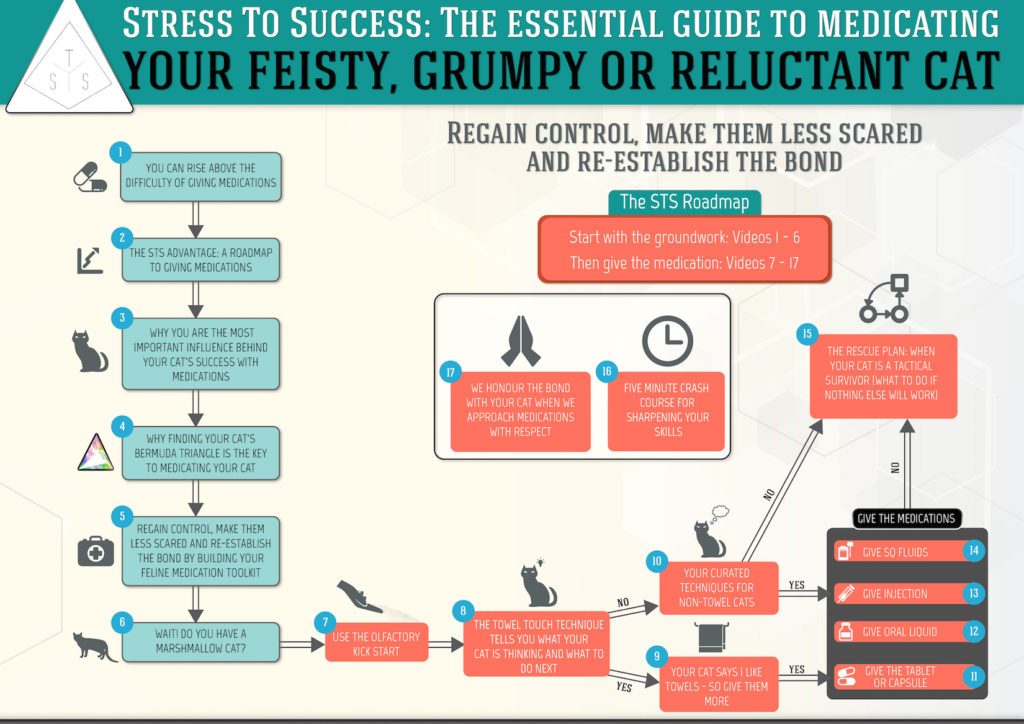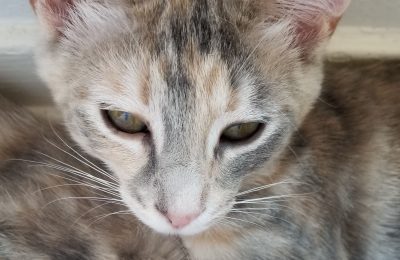 As promised, today’s blog post is an interview with Dr. Kris Chandroo. Kris is a practicing veterinarian, scientist, photographer, and feline welfare advocate! (=awesome). Kris also runs an amaze-balls website, I Will Help Your Cat, and he recently released his new educational program, called Stress to Success (STS), which teaches you how an understanding of your cat’s behavior can guide medical treatment. It’s a detailed course, which includes 17 beautifully filmed videos, handouts, and the information you need to increase the likelihood that you can medicate your cat! This is truly a labor of love and well worth the affordable price. Kris and I had a chat recently about cats and STS, and I’m happy to share our convo with you today!
As promised, today’s blog post is an interview with Dr. Kris Chandroo. Kris is a practicing veterinarian, scientist, photographer, and feline welfare advocate! (=awesome). Kris also runs an amaze-balls website, I Will Help Your Cat, and he recently released his new educational program, called Stress to Success (STS), which teaches you how an understanding of your cat’s behavior can guide medical treatment. It’s a detailed course, which includes 17 beautifully filmed videos, handouts, and the information you need to increase the likelihood that you can medicate your cat! This is truly a labor of love and well worth the affordable price. Kris and I had a chat recently about cats and STS, and I’m happy to share our convo with you today!
Tell me about Stress to Success and why you created it?
 I was looking for a way to empower people who are having a problem with medicating their cat, who are stuck, who want to maintain their relationship with their cat. It’s a way to respect that bond, but its success is also dependent on that bond. I know that my cat Zack was always there for me – and there’s an unspoken part of how we experience the pain of the loss of a cat, for many of my clients, just as or even more so than with the loss of a human family member. That bond between the owner and their cat is fundamental to who they are and to their happiness.
I was looking for a way to empower people who are having a problem with medicating their cat, who are stuck, who want to maintain their relationship with their cat. It’s a way to respect that bond, but its success is also dependent on that bond. I know that my cat Zack was always there for me – and there’s an unspoken part of how we experience the pain of the loss of a cat, for many of my clients, just as or even more so than with the loss of a human family member. That bond between the owner and their cat is fundamental to who they are and to their happiness.
Designing this course was very personal because of what I went through with my own cat, Zack, who lived almost to 22 years. As a family, we were able to do things in a way where we could spend that time with him and treat him, he was able to live his life and it wasn’t a daily struggle. What would someone else want to hear, what would they need — that I was able to give Zack, that might be harder for other people to do? I had to look at client compliance differently. When you can’t give medication to your cat, what happens?
Stress to Success is designed to show everything technical about how you can read your cat’s behavior and how to achieve medical success to give your cat a chance. At it’s core, it’s a story about your relationship with your cat. It’s about honoring that bond so at the end of the day, no matter what happens, so you know that all of your interactions were respectful.
As a vet, when you prescribe a medication, if the owner can’t get the meds into their cat – what are the repercussions for the owner?
The first is emotional. Push comes to shove, this little being needs you, you are your cat’s advocate and you thought you were going to be able to do it and you can’t. Emotionally, people feel helpless, like they are failing their cat. When people come back in the clinic, and plan one or two didn’t work – they’ve come all this way – they’ve gone through tests A, B and C – they’ve sacrificed financially, it’s like they’re climbing a mountain, they get to the top, there’s hope and then they slip and fall.
So how do we increase compliance?
There’s an alternative to compliance – concordance. Compliance is when you have a discussion with your patient – it’s a little paternal and the doctor is on a pedestal. As the patient, you are supposed to passively follow along. For a lot of cat owners I see, compliance isn’t the relationship they are looking for. They want concordance. Concordance implies a partnership. It’s a relationship between the vet, the owner, but also the cat.
Part of this course is knowing what the cat’s contribution to that relationship is. Your cat will have things to say – if we can interpret what they have to say – we can come back to the team and together make a decision. Concordance is everyone working together and realizing we all have limitations and working through those limitations for the best result. Concordance isn’t discussed a lot in veterinary medicine because behavior isn’t talked about a lot. Knowing how to interpret your cat’s behavior and putting that into the treatment plan is a major improvement that we can make.
Do you hear stories from clients about the problems they have giving medications? I hear horror stories about how people try to get their cat to the vet – using brooms and vacuums to get cats out from underneath the bed – so I could imagine people might not have bad intentions, but they might use some pretty coercive methods to try to medicate their cats.
They are desperate; they want to feel in control. I will hear back in terms of – people are usually pretty binary – it’s either working or an absolute disaster. People might make choices they regret because later they feel like they are torturing their cat.
At some point you recognized that this (difficulty medicating) was a special issue related to cats.
For some of my clients, it was SO difficult. The main thing that gets said is “They’re bad, difficult cats.” Other than some simple tricks, changing the flavor or form of medication, if things didn’t work out, hands were thrown up in the air and that was it.
That’s when the lightbulb came on for me – that other people didn’t have an experience like I had with Zack. I was at a point in my career, where on the artistic side I knew how to communicate this information and run a camera. On the technical veterinary side, I knew how things could be improved, and this was the time to bring these two things together. The video is in part a tribute to Zack, this was his experience, how can I share that with other people.
How long did it take you to finish Stress to Success?
 It took about two years. The first year was research, building the website, talking to people about the problems they were having. I was sharing Zack’s story online, and hearing people’s responses. People asked me for help because they couldn’t do it the way I did things with Zack. I thought – it would take hours and hours to have an individual conversation and repeat it for everyone who had a cat. That’s why during the veterinary visit, it’s brutal because you have 5-10 minutes after the exam to go over medication and treatment.
It took about two years. The first year was research, building the website, talking to people about the problems they were having. I was sharing Zack’s story online, and hearing people’s responses. People asked me for help because they couldn’t do it the way I did things with Zack. I thought – it would take hours and hours to have an individual conversation and repeat it for everyone who had a cat. That’s why during the veterinary visit, it’s brutal because you have 5-10 minutes after the exam to go over medication and treatment.
It took another year to film, edit and produce Stress to Success.
What did you learn when you were filming this project?
The number one thing I learned from going to people’s houses was the varied relationships that people have with their cats. There are as many dynamics between people and cats, as there are between people with each other. Some were lovey-dovey, some were completely dysfunctional (like Sid & Nancy, or Kurt & Courtney)! Some people are afraid of their cats, some are hands off, some are very hands on.
When I developed Stress to Success, the only way it could work was for it to be customizable. There’s no one size fits all for this sort of thing. People need to know what to do based on their own cat’s behavior. And oh my god – these little guys!!! – I mostly see cats in the clinic – and I logically KNEW they aren’t the same in the home as in the clinic – but when you see them in the home it is night and day, and the advice you might give someone on how to treat or restrain their cat in the clinic might work – but it’s got no bearing on what might work at home. It’s completely different.
As a veterinarian, cats have a rep in vet clinics for being scary. Do you find that a lot of veterinarians and techs are afraid of cats?
Cats have a reputation based on the fact that you have to respect them. If you’re a new veterinarian or don’t work a lot with cats, you are working with a complex individual. If you are anthropomorphic and assume that they will respond like a person would under stress, that will fail you. They have a lot of weapons and they can defend themselves very well. On the flipside, it’s a beautiful thing when you can take one of those cats, and learn what they need to cooperate. We have one cat in the clinic who normally you couldn’t touch him and he had to be sedated, we have him at the point now where with a few techniques he is calm and volunteers to be on the X-ray table. We have a partnership with him, instead of fighting with him.
This is where I think compliance fails. These little kitties need to be in the agreement. Cats need a specific skillset for handling, but when we learn to interpret their responses and know what to do, things can go well.
Do you find that people tend to interpret a cat’s aggressive behavior as mean instead of fearful?

Yes. If you come up to a cat (or even a person) who is getting aggressive, that is designed to make you feel a certain way. That’s where your training needs to tell you that instead of being offended, instead of trying to take control of the situation, you need to take a step back and realize – this little guy is simply communicating with us. There aren’t good or bad cats, they are cats with feelings who are very clearly communicating how they feel right now. That is the only way they are going to talk about it. If you think of it as communication, that is your way forward. Now I know I’m not going to put my hands on a cat’s head and create a scary scenario – I now need to work with the cat to figure out what they are telling me and how to make it better for them. It’s all communication.
Tell me about the olfactory kickstart.
 The olfactory kickstart – so, the first cats I visited for filming – my equipment case already had some of those scents (catnip, Feliway, and silver vine) on it – as a stranger, someone potentially scary to the cats – it started to pave a way for positivity with the cats. They were attracted to me, they were having positive associations. For dogs, they are often so food-motivated that giving medication is not a big deal – you just put it in their food. But many cats, when they get sick, they lose their appetite, they lose the will to eat. They don’t want that new treat, they are nauseous or sick. We needed a way to create a positive emotion through their olfactory system.
The olfactory kickstart – so, the first cats I visited for filming – my equipment case already had some of those scents (catnip, Feliway, and silver vine) on it – as a stranger, someone potentially scary to the cats – it started to pave a way for positivity with the cats. They were attracted to me, they were having positive associations. For dogs, they are often so food-motivated that giving medication is not a big deal – you just put it in their food. But many cats, when they get sick, they lose their appetite, they lose the will to eat. They don’t want that new treat, they are nauseous or sick. We needed a way to create a positive emotion through their olfactory system.
When I put together that mix of ingredients, the way they reacted before I even touched them, I knew something was there. So it was born from the recognition that food wasn’t always the answer to get them motivated, yet their olfactory system is often still working, so how can we use that to our advantage? I thought that the olfaction would only be part of the rescue plan, but it was evident from first day or two of filming that the cats really wanted this, so I tested it.
Before we met, silver vine was not on my radar. Tell me about silver vine!
There was a study on its use as part of enrichment in a shelter, she was testing different scents. Catnip was hit or miss, but in a stressful environment, silver vine has a positive effect. It’s Big in Japan (like some great bands) but we don’t hear much about it in North America. So I ordered some, and I tested it myself. In the testing phase, I found it more effective in combination with Feliway – – –
Which is how we met! Through Feliway!
Yes, I read this article you wrote about Feliway – and I agreed with it – that alone Feliway is hit or miss. Cats are individuals. But when combined with other scents – bringing multiple olfactory stimulants together, it’s a way to maximize the chances that they are going to respond. And silver vine was something that I read was more effective in a stressful environment.
Let’s talk about Feliway. I see a lot of vets – if a client’s cat is having a behavior problem – they just say “Try Feliway.”
It’s so true.
My whole criticism of it is that the research is not exactly a slam dunk. I also recognize that I may be biased, because the people it helps wouldn’t contact me for a behavior consultation. As a vet, what would you say about its use? Because I think people just plug it in and hope for the best.
The way that many veterinarians respond to behavior issues is different from how we would respond to any other medical problem. Vets love algorithms, that is how we have been trained. If your cat is vomiting, I know X-Y-Z exactly what to do right off the bat, what to do when the blood work comes in negative or positive, I know what medication or therapy to recommend – I know where to go at every step of the way whether a patient responds or doesn’t respond.
 When it comes to behavior, most of us don’t have that training. There’s no algorithm. So what we know usually comes from sticking points from conferences. The recommendation to try Feliway is because we’ve heard a lot about Fear Free and it must be a good thing, so I’m going to try Feliway. But if it doesn’t work, we don’t know why it didn’t work or what the next step is. I would never be guessing with a medical component of my job, but when it comes to behavior it feels like we’re guessing. I’m pretty sure Stress to Success is the first course like this, to have a roadmap that a client or clinician can follow. It tells you – for example, if your cat doesn’t like the towel touch technique, what they will probably respond to instead.
When it comes to behavior, most of us don’t have that training. There’s no algorithm. So what we know usually comes from sticking points from conferences. The recommendation to try Feliway is because we’ve heard a lot about Fear Free and it must be a good thing, so I’m going to try Feliway. But if it doesn’t work, we don’t know why it didn’t work or what the next step is. I would never be guessing with a medical component of my job, but when it comes to behavior it feels like we’re guessing. I’m pretty sure Stress to Success is the first course like this, to have a roadmap that a client or clinician can follow. It tells you – for example, if your cat doesn’t like the towel touch technique, what they will probably respond to instead.
You include Feliway in your olfactory toolkit – how did you come up with this olfactory combination in Stress to Succss?
I always knew I wanted to combine it – one of my colleagues, Sue Kilbourne, an amazing internal medicine specialist – what she said that resonated with me is how individualistic cats can be. Therefore, there’s a futility in a one-size-fits-all approach. I knew if olfactory stimulation was what I was going to try, my theory is that I would have a higher chance of response if I didn’t just try one thing. How do I bolster that foundation as much as possible? Let’s bring in other things that we have research about.
One of the things we bonded over was this blog post contrasting quality of life vs quantity, and that it was better to give a dog ice cream than a “nasty pill.” I respect Marc Bekoff, but I took issue with this false dichotomy, that it was pills or ice cream. I see a lot of people with cats who don’t want to “put their cat through” treatment. How do we balance quality and quantity of life and can we have both?
I hear the “putting him through this” comment quite a bit. Often that comment is code for – I’m scared, I’m uncertain, I’ve given up. When I read that article – I agree – it’s a false dichotomy. It’s not the ice cream or the pill – the road in-between is the relationship. And in any good relationship there is communication. In STS I wanted to have a scene where I was talking to someone, we’re comfortable, and then all of a sudden I reach into my pocket and stuff something in their mouth, randomly – how would that person respond? If a person did that to another person, it’s probably considered an assault.
And yet we do that to our pets and think it’s going to work out. The system failed Marc in that he should have felt comfortable calling his vet – and he admits in the article that he didn’t ask his vet – so that communication was DONE. His dog clearly said “I don’t like it this way” – but the lack of communication made it a dichotomy between pills and ice cream. When you increase concordance, you can make decisions that respect the bond.
Before someone walks out my door, I say to them, if this doesn’t work, or you have questions, I’m always available, PLEASE call me. You should see “x result by x day” and if you don’t, let me know. A lot of people take me up on that. So sometimes it’s a simple as that.
Do you feel that it’s easy to become complacent because you know a client isn’t going to follow your recommendations?
I can often tell within the first five minutes of an appointment where things are going to go – just from body language, and responses by the person. I’ll see where a person is, where their relationship is, what the limitations are. You see patterns.
Does that effect your recommendations?
If I’m the only advocate for the cat in the room, it’s never going to go well. The reality is that people have financial concerns and fears. But if I can have a conversation with them before I put my hands on their cat, we can get over that. I tell people, they are in the driver’s seat. I’m there for them, to help provide what they truly want.
I feel like we should talk about Dr. Google and people’s mistrust of their veterinarians. I see people who don’t take their cats to the vet, or don’t see medical issues. Going to people’s homes, I’ve seen loose teeth, bumps and sores, head tilts, limps. These are not people who are financially constrained. But people might first go online and do something else besides going to the vet.
There are few different reasons – the underlying psychology of why people might not go to the vet. I’m okay with Dr. Google. I have good relationships with my clients – and if I didn’t – I’m upfront enough to say I might not be the right vet for them. I encourage people to research things online, but we have a trust and rapport where they are comfortable coming back to me. Because again, it’s concordance, not compliance – I would never tell a person their choice was wrong. I would work within their abilities and philosophy, and contribute how I can. So if I look at it that way, it’s not frustrating to me. If I look at issues like vaccination and food, and extract my personal views, because those things are like religion to people – and just see myself as supporting a relationship – that’s my role. I don’t have to be right about X, Y, or Z. Oh my god, do vets have a hard time doing that! It turns into a headbutting relationship, and the pet will always lose.
Tell me how you became a veterinarian, because I know you were playing rock and roll, and also doing research in animal behavior.

I’ve always had two strong components of what I felt I needed to do – my artistic side – for me music was that thing that created consciousness. When I played guitar – music woke me up in way that nothing else did. And I always had animals in my life – growing up around birds, turtles, dogs, cats. As I went through my 20s – my interest in both music and animals equally grew. Neither went away. I got as into animals as I did into music.
 In vet school, my apartment was like a music studio, with drums and guitars and a bass in the livingroom. And then I’d be off at school during the day. I remember days at graduate school doing a research project looking at consciousness and feelings in fish, and then in the afternoon we’d go to the grad lounge and build a stage to have open-mic jams and stuff. Grad school was one of the best times of my life, it was an open place where you could roll with any idea. I was either going to do a PhD versus the vet route, and I think I would have been happy with either. But when I chose veterinary medicine, it went back to my memory of my first dog, she was awesome. But when she got sick, I couldn’t do anything, I didn’t have money for treatment, and I felt very helpless. I remember thinking I didn’t ever want to feel like that again. Vet school was my chance to not feel like that again.
In vet school, my apartment was like a music studio, with drums and guitars and a bass in the livingroom. And then I’d be off at school during the day. I remember days at graduate school doing a research project looking at consciousness and feelings in fish, and then in the afternoon we’d go to the grad lounge and build a stage to have open-mic jams and stuff. Grad school was one of the best times of my life, it was an open place where you could roll with any idea. I was either going to do a PhD versus the vet route, and I think I would have been happy with either. But when I chose veterinary medicine, it went back to my memory of my first dog, she was awesome. But when she got sick, I couldn’t do anything, I didn’t have money for treatment, and I felt very helpless. I remember thinking I didn’t ever want to feel like that again. Vet school was my chance to not feel like that again.
Do you have any pets right now?
I just adopted a cat from Cuba – he had a chemical burn – (see Kris’ website for the full story) I went down there a few months ago and brought him back. And I have two turtles I’ve had since 1987, and I have a horse. He’s a gentle giant. He’s got a big pasture, grass, and a girlfriend.
Thank you so much to Kris for taking the time to chat with me. If you haven’t cried enough today, you can watch this lovely tribute to the cat who started it all for Kris, Zack, who passed away earlier this year at age 21.




Just shared. This is the most exciting cat news I’ve read in ages. Thanks so much for sharing. Can’t look at the video just yet having recently lost my 21-yer-old recently. Btw, since my last email, I finally launched Black Cats Tell All, my nonprofit anthology on Kickstarter to promote black cat adoption! http://kck.st/28RAHfW
Layla, I agree, I’m so excited about what Kris is doing, and he’s a great guy to boot! Thanks for letting me know about Black Cats Tell All!
I love everything about this interview. I’ll be sharing Dr. Kris’ Stress To Success information with my clients, many of whom have cats with health issues and who are taking meds. I have a 17 year old kitty who is currently on medication, and I foresee myself taking the STS course soon. Thank you SO MUCH for this interview!
Marci, thanks! It was really fun to do this interview and I think STS is a great program! Kris really cares about cats!
Very exciting! Medicating cats is so stressful for most of my clients and they usually just give up. Can’t wait to share this!
What an excellent interview packed with great information. I love Dr. Kris’ approach for achieving concordance and am excited to learn more through his STS program. Thank you for highlighting this extraordinary cat advocate. I’m off to research silver vine now.
Hi where is Dr. Kris Chandroo located? I really would like to bring my cat to him. and it is urgent 911 time…for kitty-
Rachel, he is in Canada, and I recommend you do not hesitate to take your cat to a veterinarian ASAP if it is truly urgent.